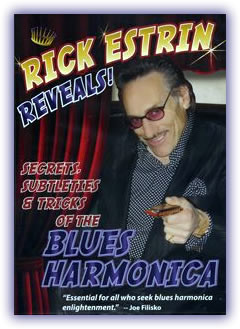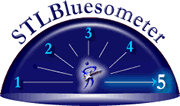 By
East Side Slim By
East Side Slim

Rick Estrin – Rick Estrin Reveals! Secrets,
Subtleties & Tricks of the Blues Harmonica
– artist-released (no label), 2008
Headin’
Out
Welcome to the review of Rick Estrin’s new
harmonica players’ instructional DVD, “Rick
Estrin Reveals! Secrets, Subtleties & Tricks
of the Blues Harmonica”, produced and written
by Rick. Right from the introduction to the video,
where Rick comes across a man in an alley “abusing”
a harp, then throwing said harp into a nearby dumpster,
you know that you’re in for something a little
different here – especially as far as music
instruction videos are concerned.
Rick’s own spoken introduction makes it abundantly
clear that he possess vast knowledge about playing
harp, and that he takes playing the harp very seriously.
That being said he also makes it clear that you’re
going to have some fun learning from him (if you
listen!) – and that you’re going to
be treated to a few pretty young ladies along the
way. There’s nothin’ wrong with that!
Estrin also lives up to his vaunted sartorial reputation
by donning several choice suits throughout the proceedings.
Rick makes it clear that this DVD was not put together
with the beginning player in mind, or the player
who is not yet tongue blocking. He directs players
at these levels to several excellent sources of
instruction. While I agree with the technical aspects
of what Rick is doing being beyond elementary players,
there is still much to gain for those players from
viewing this DVD, especially the aspect of learning
to listen – which Rick comes back to again
and again. I know from my own blues journey that
there are things I hear and enjoy now that 10 years
ago I didn’t understand – in fact, I
just couldn’t hear them yet.
With the help of his trusty side-kick George (Rusty
Zinn), Estrin discusses his ideas, and then gives
vivid and engaging examples of each. This includes
examining the varying playing styles of several
legendary players’ styles – to include
Sonny Boy 1, Sonny Boy 2, Little Walter and Big
Walter Horton. Rick manages to pack an enormous
amount of information into an entertaining hour
of instruction, with this instruction being broken
down into the following seven chapters:
1)
Hold That Groove
2) Ear for Detail: Listening for Subtleties
3) Phrasing and Soloing Strategies I
4) Phrasing and Soloing Strategies II
5) Learning “Note for Note”
6) Revealed for the First Time: Performance Tricks
and Showbiz Devices
7) Outro: Back from the Alley
The Chapters:
1.
Hold That Groove:
--This 1st chapter of the video concerns itself
with developing a groove to your playing –
how to feel that pocket. It’s an elemental
piece to his instruction, one Rick will revisit
often throughout the course of the DVD. Several
topics are discussed and played (examples given),
including the following:
• Holding your time – how it is not
the same as groove.
• How to play around with “time”
in order to achieve dramatic effect
• Why you need to move around while playing
• Players need to “feel the space in
between the notes” – Estrin heavily
stresses this point
• How relaxed, fluid playing leads to “interesting
and conversational playing – casual intensity”
• When playing with other players –
listen to what they are doing
• Do not force-fit pet licks – play
to the music
• Breathe through the harp – chord support
• What you play needs to sound natural –
don’t sound stiff!
2. Ear for Detail: Listening for Subtleties
--In this 2nd chapter, Rick expands upon the idea
of developing your listening skills if you want
to become a better player. He continues to emphasize
and flesh-out each thought and idea with many playing
examples. Some of Rick’s main thoughts in
this chapter include:
• When listening to music… if it moves
you, listen to it over and over again
• Subtleties of playing are in reality a “combination
of musical devices designed to manipulate the emotions
of the listener” – a musical sucker
punch if you will (folks, pay special attention
to Rick’s face when he delivers this line…)
• Develop and use different shapes (hand shaping)
and tones for contrast
o Octaves, chords, warbles, octave warbles, flutters,
tongue-slaps, partial chords, double-stops (intentional
slop), swoops and slides, swells, vibratos, soaring
(sharpening notes) and growls
• Listen for sounds textures and tones –
including repetition; use to build dramatic effect
• The same note is available on different
draw and blow holes – important for breathing
and for The Groove.
• Pay special attention to the way “great
musicians alternate the predictable with the unpredictable,
and the tools they use to achieve this”
• Listen for small details and nuances
• “Listening isn’t passive –
it’s an activity”
• “Turn your ear into an audio microscope;
train yourself to be an more focused listener”
3. Phrasing and Soloing Strategies I
--The main point in this segment, which all the
other information reinforces, is that “a technically
limited player can sound cool as hell” if
he is good at phrasing and can maintain The Groove.
Much of Rick’s time in this section is spent
on playing you actual examples of how to work phrasing,
tonal changes and devices into the different types
of verse structures. Main points of chapter 3 include:
• Phrasing is one of the most important difference
makers between sounding great and sounding mediocre
• You want to tell a story with your playing
– a lick is only meaningful in context
• Several types of verses are discussed
o Rhythmic
o Linear/Melodic
o Riff – think big band horn section
• One of the most effective tools you can
have is contrast.
4. Phrasing and Soloing Strategies II
--Chapter 4 expands on Phasing and Soloing Strategies
I, with Estrin using many more playing examples
to show the listener exactly what he’s talking
about. The vast number of playing examples contained
in the DVD is what really makes this instructional
method work so well. Rick isn’t just talking
at you; he is actually showing you, too. Main points
from chapter 4 include:
• Messing with the time: playing straight,
a little ahead or a little behind
• Hit the listener with strategic surprises
– leave holes
• Setting up a phase with a “pick-up”
• Contrast long phrases with short phrases
• Use hands in conjunction with bends to shape
notes
• You should be looking for a more human,
vocal-type quality to your playing
5.
Learning “Note for Note”
--What exactly is the value of learning classic
blues songs/styles note for note?
• It’s about learning the language of
the blues, which was established a long time ago
• It’s about speaking the language and
being able to communicate your own story through
your harp (which is a combination of everything
Rick has talked about up to this point)
6. Revealed for the First Time: Performance
Tricks and Showbiz Devices
--This chapter is funny as hell, but serious, too.
It deals with tricks used to capture and hold the
attention of the listener. Rick makes the following
disclaimer prior to disclosing his tricks: “you
have to feel this stuff to make it work –
visualize and internalize it first” –
it’s a progression, a growing process. The
tricks Rick describes include:
• “The Look”
• “Damn, this shit is deep”
• “The Rule of Three” –
just messed up? Play it 3 times with confidence
• Look Ma, no hands – playing the harp
without using your hands
7. Outro… Back from the Alley
--This last chapter acts as a fun conclusion to the
DVD. Rick’s “pupil” might’ve
taken to the lessons too well, as he got the girls
this time around instead of Rick. Estrin leaves us
with some parting words of wisdom about becoming a
better harp player: “the real secret is…
keep it in your mouth!”
The Verdict: Honestly,
I can’t say enough about how entertaining
and enlightening this instructional DVD is. It was
made with a lot of care, and the countless playing
examples serve to illustrate the ideas, thoughts,
tricks, etc… that Rick is trying to impart
to the viewer. It’s a shame more instructional
videos aren’t made along the lines of this
one, because making learning fun makes it easier
to learn. Also, you won’t be inundated with
music theory here. The bulk of things discussed
here go beyond theory, into the realm of “feel”
– or The Groove. While most beginning players
won’t be able to jump right in and make Rick’s
ideas part of their arsenals, there are plenty of
things they can take away that will help to improve
their playing. Most important among those –
LISTEN! Time to rate this project; I’m giving
Rick Estrin’s “Rick Estrin Reveals!
Secrets, Subtleties & Tricks of the Blues Harmonica”
a 5.00 on the STLBluesometer. The video succeeds
on many levels, and even if you don’t play
harmonica I still recommend it for he fun you’ll
have watching it. For anyone who is still unsure
of the veracity of my review, I’ll leave you
with two quotes found on the DVD notes, each from
a noted harmonica master:
• “His twenty-five year of performing
all over the world as the frontman for Little Charlie
and The Nightcats – now Rick Estrin and The
Nightcats – has given him a wealth of experience
which he now shares with you. I guarantee that you’ll
learn a lot, and as is always the case with Rick,
be hugely entertained along the way.” - JERRY
PORTNOY
• “Essential for all who seek blues
harmonica enlightenment.” – JOE FILISKO
Lee Howland
- aka "East
Side Slim"
 |
|
